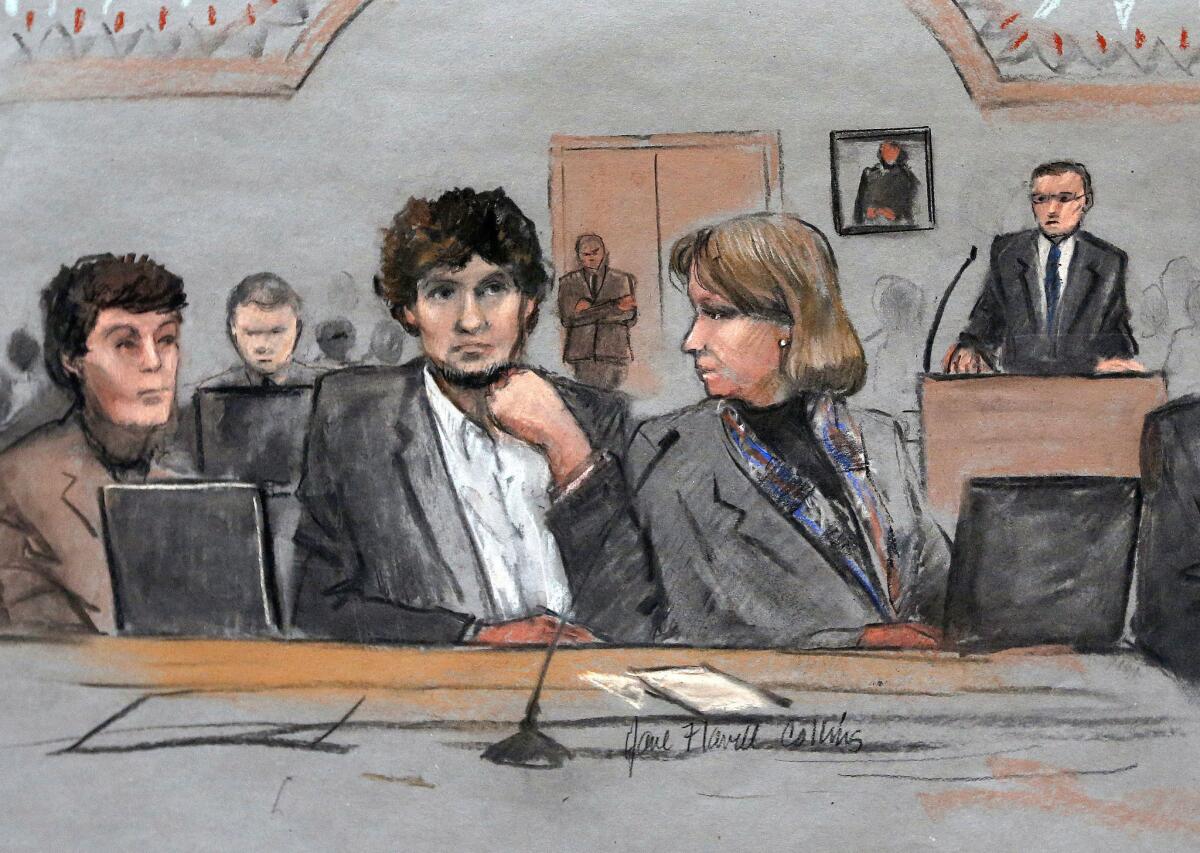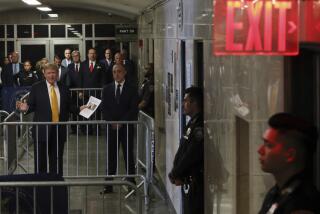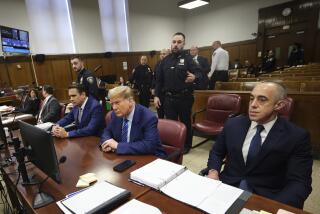Defense’s goal in Boston Marathon bombing trial: Save Dzhokhar Tsarnaev’s life

Reporting from Boston — The capital murder trial in the Boston Marathon bombing is moving so quickly that a verdict against Dzhokhar Tsarnaev could come as soon as the next two weeks.
Given his attorney’s surprising admission during opening statements that the 21-year-old Russian immigrant detonated one of the two pressure-cooker bombs in April 2013, Tsarnaev is almost certain to be found guilty.
The only cliffhanger now is whether the jury will sentence Tsarnaev to death, as U.S. prosecutors want, or spare his life, which has become the primary pursuit of his defense team.
“It is the sentencing phase,” said Boston College Law School professor Robert Bloom, “where you win or lose.”
Wrapping up its third week, the trial on the third floor of the downtown federal courthouse on Boston Harbor is one of the government’s biggest terrorism-related prosecutions since the Sept. 11 attacks. A sentence of life in prison without parole would be seen as a blow to federal attorneys, who ignored pretrial overtures to reach a plea bargain that would have removed the option of the death penalty.
Tsarnaev’s defense team, which until recently sought to delay the trial, is now practically rushing through the first phase, when guilt is determined. In a bold but risky strategy, his lawyers are betting it all on winning the jury’s mercy and portraying their young client as a pawn of his older brother, Tamerlan Tsarnaev, who they say was the real mastermind.
As the government has presented gruesome evidence and called traumatized victims to the stand, defense attorneys have thus far kept cross-examination to a minimum, sometimes allowing as many as eight or more witnesses to testify a day, often at a fast clip. A trial once expected to last until June may wrap up next month.
It’s even unclear whether the defense will put up any evidence of its own or call witnesses in the first phase, perhaps opting to move more quickly to the sentencing hearing, where punishment will be decided.
Stephen Jones, lead defense counsel for Oklahoma City bomber Timothy McVeigh, applauded the Tsarnaev defense for admitting its client’s responsibility. That kind of honesty with the jury, he said, might win leniency in the sentencing phase.
“It gives them some credibility with the jury, which probably believes he did it anyway,” Jones said. “So you want to use the first phase of the trial to get to the second phase, and that’s where they might win it with a life sentence.”
At the same time, because the defense is still formally pleading not guilty, it preserves the option to later appeal any conviction or sentence. That is crucial because death penalty convictions typically spend decades tied up in appellate courts.
For the defense, it is convenient that Tamerlan Tsarnaev is not alive to defend himself and deflect their strategy. He was killed several nights after the bombings, shot by police and then run over by Dzhokhar Tsarnaev as the younger sibling fled in a car. The next evening Dzhokhar Tsarnaev was found hiding in a boat in a backyard in the Boston suburb of Watertown, Mass.
To the degree that defense attorneys have participated in the last three weeks, they have focused on portraying Dzhokhar as more inclined to play video games than build bombs, more likely to chase girls than embrace jihad. While they acknowledge that some of his Internet searches included radical ideology, they say he rarely downloaded them.
They have emphasized that the surveillance videos of the marathon show Dzhokhar Tsarnaev walking behind the lead of his older brother. In writings he made while hiding in the boat, Dzhokhar said he was “jealous” of his brother for dying as a martyr.
And when prosecutors presented Dzhokhar Tsarnaev’s Twitter messages about radical jihad, the defense noted that he also tweeted about girls and cars. Defense lawyer Miriam Conrad called those “normal interests” for a young man.
She also challenged an FBI agent’s testimony that his Twitter picture was of Mecca, showing it actually was a portrait of Grozny, capital of the Russian republic of Chechnya. Tsarnaev is an ethnic Chechen.
In one of their most spirited moves during the prosecution’s case so far, defense attorneys insisted that the jury see the entire boat, not just the panels with Tsarnaev’s writings.
On Monday morning, Judge George A. O’Toole Jr., the jury, prosecutors, defense lawyers and Tsarnaev inspected the boat at an off-site location. Defense attorneys hoped the blood-stained craft with more than 100 bullet holes would create sympathy and show that police nearly killed their client before he surrendered.
Also this week, a friend testified about Dzhokhar Tsarnaev’s fear of his older brother, describing him as “very strict … very opinionated.” And on Wednesday the defense got a government witness to testify that receipts for the backpacks that held the bombs were found in Tamerlan Tsarnaev’s wallet.
A similar tactic played out in the Beltway sniper shootings of 2002, in which 17-year-old Lee Malvo claimed he was under the influence of an older father figure when they killed 10 people in the Washington, D.C., area. After separate state trials in Virginia, the older man, John Allen Muhammad, was executed and Malvo received life in prison.
Attempts to portray Dzhokhar Tsarnaev as a lost college student are on display in the courtroom. Tsarnaev appears in a dark sport coat, his beard thin, his black curly hair largely unkempt. He seems disinterested, sometimes bored. He doodles on a legal pad, or looks away. He sits between two older female lawyers at the defense table who at times seem to be mothering him.
Aware of what the defense is trying to do, prosecutors are using the trial as best they can to show Tsarnaev as cold and calculating, every bit a “partner” in the bombings that killed three people and injured more than 260 others.
On Thursday, an FBI official testified, leading the jury through data on the defendant’s laptop, saying that the day before the bombings someone — presumably Tsarnaev — read an article from the Al Qaeda magazine “Inspire” with instructions on how to “Make a Bomb in the Kitchen of Your Mom.”
Previously, they called a father to testify about seeing his young son die and his young daughter lose both her legs. Late last week, a young man described the horror of being carjacked by the Tsarnaev brothers during the manhunt. He recalled that Tamerlan bragged about killing a police officer while Dzhokhar was somewhat polite, even asking if it was OK to play music in the car.
Most chilling was the video montage of the brothers walking through the marathon crowd, the bombs going off, and then Dzhokhar nonchalantly walking away. He next casually purchases milk at a local market, and later hits the gym at the University of Massachusetts Dartmouth campus.
Prosecutors have presented much of the harrowing victim testimony at the end of each day, hoping jurors spend their off hours remembering the images of torn bodies and severed limbs. The same tactic was used by prosecutors in the 1997 trial for McVeigh, the last person executed by the federal government for terrorism in this country.
Experts warn that federal juries can be hard to predict. Other federal terrorism death penalty cases have come up short for the government, most notably in the 1993 World Trade Center bombing in New York and the trial of Zacarias Moussaoui, the self-described “20th hijacker” on Sept 11. In both cases, the men were given life sentences with no parole.
In the first World Trade Center bombing, jurors feared that a defendant on death row would become a martyr, and that a death sentence might only inspire other radical militants to attack the U.S. In the Moussaoui case, an expert defense witness testified that life with no parole — what he called “slow rot” — can be harsher than death.
Edward B. MacMahon, a Moussaoui defense attorney, said federal juries were often disgusted when the defendant prefers execution. “Jurors start to think that’s what they want, that the only time anyone would care about them is if you killed them,” MacMahon said.
In Boston, there may be factors working in favor of Tsarnaev’s bid to avoid the death penalty. For one thing, capital punishment is highly unpopular in this New England state, and it is forbidden in state trials. Tsarnaev is eligible because his is a federal case.
Bloom, the Boston College law professor, said jurors also may see a life sentence as a way to heal emotional scars by ending the case and the unavoidable appeals triggered in a capital murder case.
“If he gets the death penalty, he will just file more and more appeals,” Bloom said. “And the city will continue to suffer.”
richard.serrano @latimes.com
@RickSerranoLAT
More to Read
Sign up for Essential California
The most important California stories and recommendations in your inbox every morning.
You may occasionally receive promotional content from the Los Angeles Times.










